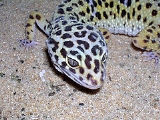
Eublepharinae
Encyclopedia
Eublepharinae is one of five subfamilies of the Gekkonidae, or geckos. Eublepharinae has 27 species in five genera
. Also called eyelid geckos, the Eublepharines have more primitive features than other geckos. In particular, their feet lack the modifications that allow most other geckos to climb sheer surfaces. Unlike other geckos, they also have movable eyelid
s. They are nocturnal lizards, often preying
on insects and similar creatures. They lay a pair of leathery eggs
, and, in at least some species, the sex of the young is determined by the temperature of incubation, as in crocodile
s.
The subfamily contains the following genera
:
Genera
Genera is a commercial operating system and development environment for Lisp machines developed by Symbolics. It is essentially a fork of an earlier operating system originating on the MIT AI Lab's Lisp machines which Symbolics had used in common with LMI and Texas Instruments...
. Also called eyelid geckos, the Eublepharines have more primitive features than other geckos. In particular, their feet lack the modifications that allow most other geckos to climb sheer surfaces. Unlike other geckos, they also have movable eyelid
Eyelid
An eyelid is a thin fold of skin that covers and protects an eye. With the exception of the prepuce and the labia minora, it has the thinnest skin of the whole body. The levator palpebrae superioris muscle retracts the eyelid to "open" the eye. This can be either voluntarily or involuntarily...
s. They are nocturnal lizards, often preying
Predation
In ecology, predation describes a biological interaction where a predator feeds on its prey . Predators may or may not kill their prey prior to feeding on them, but the act of predation always results in the death of its prey and the eventual absorption of the prey's tissue through consumption...
on insects and similar creatures. They lay a pair of leathery eggs
Egg (biology)
An egg is an organic vessel in which an embryo first begins to develop. In most birds, reptiles, insects, molluscs, fish, and monotremes, an egg is the zygote, resulting from fertilization of the ovum, which is expelled from the body and permitted to develop outside the body until the developing...
, and, in at least some species, the sex of the young is determined by the temperature of incubation, as in crocodile
Crocodile
A crocodile is any species belonging to the family Crocodylidae . The term can also be used more loosely to include all extant members of the order Crocodilia: i.e...
s.
The subfamily contains the following genera
Genus
In biology, a genus is a low-level taxonomic rank used in the biological classification of living and fossil organisms, which is an example of definition by genus and differentia...
:
- ColeonyxColeonyxColeonyx is a genus of terrestrial geckos commonly referred to as banded geckos. They are found throughout the southwestern United States, Mexico and south into Central America. They are relatively small lizards, measuring about inches in length...
(7 species) - EublepharisEublepharisThe genus Eublepharis was first described by the British zoologist John Edward Gray in 1827. The etymology of their name is 'eu' = Good |'blephar' = Eyelid, and all have fully functional eyelids. Members of this genus are found in eastern and southwestern Asia where they are found in arid and...
(5 species) - GoniurosaurusGoniurosaurusGoniurosaurus is a genus of geckos, containing eleven species. Members of this genus range from China, Japan and Vietnam. For this reason they are known as Asian geckos.- Classification of genus Goniurosaurus :luii group...
(11 species) - HemitheconyxHemitheconyxHemitheconyx is a genus of gecko.-Classification of genus Hemitheconyx:*African fat-tailed gecko, Hemitheconyx caudicinctus*Taylor's Fat-tailed Gecko, Hemitheconyx taylori...
(2 species) - HolodactylusHolodactylusHolodactylus is a genus of small geckos, collectively known as African Clawed Geckos.-Distribution:Both species in the genus live in North-eastern Africa. The range of Holodactylus africanus stretches from the Maasai Steppe, on the border between Kenya and Tanzania to Ethiopia...
(2 species)

